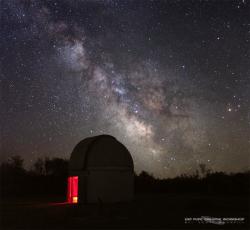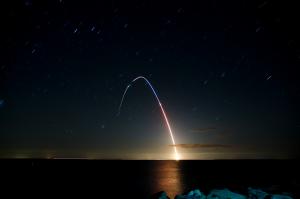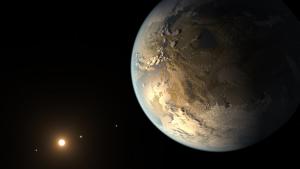
Public Stargazing
- Where:
- Frosty Drew Observatory
- When:
- Friday April 18, 2014 at 7:00 p.m.
- Cost:
- $1 Suggested Donation per Person
Tonight's forecast is calling for partly cloudy to mostly cloudy skies becoming clear overnight. The 87% waning gibbous Moon will rise near 11:30 p.m. leaving dark skies to boot. We plan to open at 7:00 p.m. in the Sky Theatre with a presentation on objects we typically view the Observatory using astro-photos shot at Frosty Drew. At 8:00 we will attempt to open the observatory telescopes if the skies permit. We will focus the telescopes on Jupiter, Mars, and the Moon with an emphasis on Mars, which has been putting on quite a show these past few nights. Be sure to keep up with us on Twitter (@FrostyDrewOBSY) for status updates from the observatory. This will help keep you informed of conditions before trekking out. If skies are clear enough, make it a priority to come out and see Mars at it's best.
-------------------------------------------------------------------------
Weekly Happenings
Scott MacNeill
This morning, the Lunar Atmosphere and Dust Environment Explorer (LADEE) probe that has been orbiting the Moon at super low altitudes, crashed (as expected) into the lunar surface in a violent, 3,600 mph, crater forming event on the far side of the Moon. LADEE has been in orbit around the Moon since October 2013 with the goal of studying the thin lunar atmosphere, called an “exosphere”, to help boost our knowledge of what is likely the most common type of atmosphere in existence. The LADEE probe also carried on board a next generation, laser based, deep space communication system that was successfully tested shortly after LADEE's launch and will increase bandwidth and data transmission speeds exponentially. Between 12:30 and 1:22 a.m. this morning the LADEE craft descended to less than 1 mile from the lunar surface in a planed descent allowing researchers to collect unprecedented data before it's final plunge into the lunar surface. The impact site will be studied in the near future by the popular Lunar Reconnaissance Orbiter (LRO) with stunning snapshots sure to follow. The planned demise of the LADEE craft hits home a bit for us at Frosty Drew as we all were mesmerized on that late Summer Friday night when LADEE's beautifully brilliant launch lit up the sky for all of us who looked to the stars that night.
Yesterday, an announcement was made that will surely make history books. The NASA Kepler mission has discovered the first Earth-sized planet outside of the Solar System that resides in the habitable zone of it's parent star. The planet - named Kepler-186f, is just slightly larger than Earth, almost certainly a rocky planet, and lies 490 light years distant from Earth. Though Kepler-186f is the most Earth-like planet found to date, the star system that it takes up residence in is quite different than conditions as we know in the Solar System. Kepler-186f is in orbit around a red-dwarf star named Kepler-186. Red dwarf stars are significantly cooler, smaller, and dimmer than the Sun. So the habitable zone, where liquid water can exist on the planet's surface, is significantly closer to the star. This places Kepler-186f slightly closer to it's parent star than the orbit of Mercury is to the Sun, making one year on Kepler-186f only 130 Earth days. Being that it's parent star is so much dimmer than the Sun, the brightest part of the day on Kepler-186f would be about as bright as one hour before sunset on planet Earth. Kepler-186f is one of five known planets that make up the Kepler-186 star system and is the furthest planet from it's parent star. These differences make Kepler-186f less of a Earth-twin and more of an Earth-cousin. Further study will need to happen before we can be sure of what elements exist in Kepler-186f's atmosphere. Though any sign of Oxygen, Methane, or Ozone would be strong indicators of biological processes. Regardless of the outcome, the discovery of Kepler-186f is a pivotal moment in the search for another place as awesome and beautiful as Earth - the only home we have ever known.
-Scott


